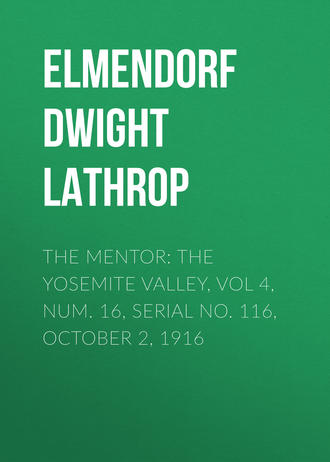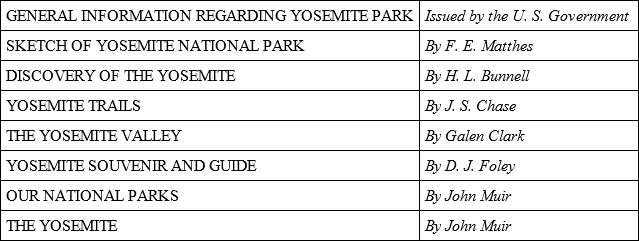
The Mentor: The Yosemite Valley, Vol 4, Num. 16, Serial No. 116, October 2, 1916
The Mariposa Grove – which was discovered in 1857 by Galen Clark – lies in a little valley occupying a depression on the back of a ridge. The Lower Grove contains 240 fine Big Trees. The Grizzly Giant is the largest of all. It has a circumference of ninety-three feet and a diameter of thirty and six-tenths feet. Its main limb is six and one-half feet in diameter. This tree is very much injured, and its size has been decreased by burning. It has long since passed its prime, and has a battered and worn appearance.
In ascending to the Upper Grove the road goes through a tunnel cut through the heart of the “Wawona,” a living Sequoia. This tunnel is ten feet high and nine and one-half feet wide at the bottom.
The Upper Grove contains 360 Big Trees, averaging in age about 2,500 years. About ten of the trees exceed 250 feet in height. Three of these have a circumference of over ninety feet.
The bark of the largest trees is from one to two feet thick. Toward the end of winter the trees bloom, while the snow is still eight or ten feet deep. The flowers are pale green and pale yellow. The seeds are small and light. The cones remain on the tree for many years.
The Big Trees might live forever. There is no absolute limit to their existence. Death is due only to an accident. The leaves alone die of old age, and these are renewed.
THE YOSEMITE VALLEY
By DWIGHT L. ELMENDORF
Lecturer and TravelerMENTOR COLOR PLATESCATHEDRAL SPIRESYOSEMITE FALLSEL CAPITANHALF DOMETHREE BROTHERSVIEW FROM GLACIER POINT TRAILEntered as second-class matter March 10, 1913, at the postoffice at New York, N. Y., under the act of March 3, 1879. Copyright, 1916, by The Mentor Association, IncRest here for a time by the side of the Merced River while I tell you something of this peaceful, lovely valley. Look over to that further cliff and watch the silver stream of the Yosemite descend in three gleaming white steps from the summit of rock 2,600 feet above us to the meadow level where we stand. In its first flight of 1,430 feet it falls a third of that distance in a snowy column, then turns to wreathing smoke, through which many glistening darts shoot down to the rocky basin below. Here the misty elements are resolved again into water, and the stream tumbles frothing through rocks to its second flight, then on to the lower fall of 320 feet, when it dashes on a bed of boulders and hurries to join the Merced River.
It is an ever present sight in the heart of the Valley, and our eyes turn to it frequently during the hours of daylight. And, all through the night, we hear the hushing sound of its falling waters as it whispers to us of the many beautiful things that Nature has given us in this valley of enchantment.
So you see Yosemite in midsummer. Then its fall is almost as fairy-like as that of Bridal Veil. But in April and May, when it pours down the accumulation of the winter snows, it is a foaming torrent, and its tone is deep and strong.
The Yosemite has been gradually disclosing its features to us since early morning. The first impression that we experience as we leave the town of Merced is one of steady ascent into a narrow gorge, through which a busy, turbulent stream – the Merced River – pursues its course. The train labors sturdily up until it reaches El Portal, where there is a pause at the hotel for lunch. Then the trip is resumed in auto buses that take us on up through a valley, winding and narrowing into a notch that seems at times as if it would end in sheer walls of rock. But, in the course of an hour or more the way broadens, and we find wider stretches, wooded with tall pines and stately sequoias.
Then we catch a glimpse of Elephant Rock, of Cathedral Spires, of the delicate lacery of Bridal Veil Falls, and, opposite, the massive bulk of El Capitan. Soon the slender, swanlike neck of Yosemite Falls appears, and we roll through Camp Awahnee and out into the wide, level vale where Yosemite Village rests. Here we draw a long breath, and a sense of peace and contentment takes possession of us – a feeling of complete isolation from the world of care and trouble. There is something so intimate and friendly – so “homey” – about the wide, green meadow that stretches before us from the banks of the fast flowing Merced to the wood at the foot of Yosemite Falls. Around this level mead the camps cluster; Yosemite, El Capitan, and Lost Arrow camps close to the base of the falls, quiet Camp Awahnee by the roadside across the river, and busy Camp Curry a mile east of the village and just below Glacier Point.
Yosemite National ParkWe are now in the very center of Yosemite Valley – though not of Yosemite National Park. Do not mistake the part for the whole. The Yosemite National Park – created a park October 1, 1890 – is a huge tract of land, 1,124 square miles in area. It contains many valleys, mountains, streams, lakes, and waterfalls. Its vast territory has been explored by countless travelers, and it is the favorite playground of the Sierra Club – a body of hardy and adventurous men and women trampers, campers, and mountain climbers.
The particular gem of the Yosemite National Park is our dearly treasured Yosemite Valley, seven miles in length – and that is what we have come to visit. When we arrive there we reach a high elevation. The floor of the Valley is 4,000 feet above sea level, and on all sides the mountains rise to heights varying from 3,000 to 6,000 feet more. The highest point in the Valley is the summit of Cloud’s Rest, which is nearly 10,000 feet above sea level.
And, now that we are here, you ask: “What is this valley, and how did it come to be?” There are several geological explanations of it, varying in character. Prof. J. D. Whitney, the first scientist to study the Sierra, thought that the Yosemite was “the result of the sinking of a local block of the earth’s crust having the exact outlines of the Valley,” and he denied that glacial action had anything to do with it. But the generally accepted explanation is that the Valley was once a tortuous river canyon cut by the Merced River, and that the cutting work of this stream was done so fast that the “tributary valleys soon remained hanging high on either side.” Then the canyon became the bed of great glaciers which, in moving, “scooped” the Valley into its present form. This, of course, was a matter of hundreds of thousands of years.
Accepting that explanation as correct, many of the natural conditions that we find in the Valley are easy to understand – such as the smooth polished surfaces of El Capitan and Half Dome.
And now you ask: “What is there to do and see?” It is a valley of varied diversions. There are many things to do and many beautiful spots to visit, and you may choose according to your tastes and your physical ability. Are you a sturdy tramper? You may take your pack and staff and assail the mountain citadels that challenge you on every side. Do you love the saddle? You can find bridle paths that will lead you through the cool, dense woods, by lakesides, to the foot of waterfalls, and up to the summits. Are you unequal to the exertion of tramping or riding? The joys of the Yosemite are yours none the less, for high powered auto cars will carry you in comfort to the points of greatest interest in the Valley, out to the groves of giant trees, and even up to the supreme commanding spot of all – Glacier Point.
You may take in the Yosemite as a visiting tourist, in which five or six days may suffice you for sightseeing, or you may settle down as a camper or hotel guest, in which case days and weeks slip by, and you soon lose all sense of time in the sweet repose of the Valley. For the greater number a touring visit is all that is possible. You tell me that you are here for a few days. How may you best occupy them? It is not necessary for me to answer your question in detail, for the affairs of the Valley have been systematized in a most businesslike fashion, and all such information is ready to hand. You can obtain schedules of trips for two, three, four, and on up to nine and ten days. The United States Government has done and is doing a good work in developing this great natural recreation park, and all the Government asks of us is that we will take advantage of it. The attitude of Uncle Sam is expressed in the legends posted on trees throughout the Valley, all of which mean in substance: “This beautiful park is yours. Help us to preserve it and make it attractive.”
Evening in the ValleyWe have come up from Merced in the morning, and we have arrived in the Valley at three o’clock. Let us make the most of the remainder of this fair summer afternoon. We walk out across the green meadow for a closer view of Yosemite Falls. The shadows of El Capitan and the Three Brothers are already creeping over the valley, and the air has a touch of evening cool as we enter the woods. The walk is longer than we thought. The tall, sheer cliffs make the falls seem nearer than they are. At length, after pursuing the path for some distance through the woods, we come upon an open spot from which we can gaze up and drink in the beauty of the three white leaps of water. This is the favorite spot – the choice viewpoint of artists and photographers. A short climb brings us to the foot of the lower falls, and there we rest and watch the seething basin while the soft mist plays upon our faces. The woods about us are in deep shadow and odorous of pine. Above us goes the trail that leads up through a narrow gorge to a point at the summit of the falls. We are seated in the very sanctuary of the Yosemite. It is an hour to remember.
On returning, we pause a moment by the roadside on the meadow at the concrete bench placed there in memory of Galen Clark, a lover and student of the Yosemite, and discoverer of the giant trees of the Mariposa Grove. Galen Clark apparently drew vitality from his aged tree friends, for he lived to be 96 years old. He is buried in the Valley, and the concrete bench is placed on the spot where he frequently sat to gaze on the falls. Though it is now evening and the sun has disappeared, the Valley is suffused with soft reflected light from the huge flat, mirror-like face of Half Dome. In the course of an hour the golden glow on that great oval surface of rock far above us turns to shimmering silver, and then to a ghostly gray that finally gives way to night.
Mirror Lake and Happy IslesIn the early morning let us go to Mirror Lake. This beautiful little sheet of water lies not far from the village and in a natural bowl at the foot of Half Dome and Mount Watkins. The mirror effects are best seen in the early hours shortly after sunrise.
On the way back stop for a half hour at Happy Isles. That brief visit will not suffice you, for you will find time, even in a short stay in the Yosemite, to slip away for several half hours to the quiet shades and laughing waters of Happy Isles. The Merced has woven a necklace of sparkling waves about these little wooded islands, and made of them an ideal retreat for a sunny afternoon. If you rest there late in the day look for the dainty little water bird that John Muir calls the “water-ouzel.” I watched one for an hour on the lower island. He has his nest close to the surface of the stream, and he plays joyously, half in and half out of the water, part time flitting over the spray, and part time dipping under, until his sleek gray-black coat shines like satin.
There are trails and roads in all directions. What will you choose? Since you have now seen Happy Isles, go on to the foot of Vernal Falls. You have simply to follow the path past Happy Isles, and go on up the Merced River. It will repay you, for Vernal Falls is a beautiful down-pour of water, 317 feet in height. And, while you are following this trail, go on still further till you reach Nevada Falls, the most impressive of all the cataracts in the Park. Its height is 594 feet, and the volume of water that it pours exceeds that of any of the others. If you would get an adequate impression of its power, climb to the top of Nevada Falls and look down. You will not forget the sight.
If you love fishing, you would do well to take your rod on such a trip, for trout can be found in the pools of the Merced. If fishing is your main object, follow the trail on up to Merced Lake, where you may be assured of finding a full day’s sport.
If, however, tramping and climbing are your choice, you can continue from Nevada Falls and go on one or the other of two splendidly adventurous trails – either turning up to the left to climb the summit of Cloud’s Rest or Half Dome, or winding to the right to reach far-famed Glacier Point. If you take the latter trail you will catch a fine view of Illilouette Falls, a beautiful cataract 370 feet in height, seen only by hardy climbers.
Glacier PointYou may not be equal to such a climb. If so, save Glacier Point for a special trip – on muleback if you can stand it; if not, then go up the road in an auto car. There are a number of ways of scaling Glacier Point. I have mentioned one trail. The bridle trail goes up the long way and comes down the short – all done in one day if one chooses. This trail offers many scenic beauties and some real thrills for those unaccustomed to dizzy heights. The shortest way of all is what is called the “ledge trail,” which starts near Camp Curry, directly underneath Glacier Point, and goes pretty nearly straight up. This calls for the sturdiest kind of climbing – and some nerve.
“All very well,” exclaims the timorous, “but for me, the auto car.” And, indeed, the auto car trip offers many advantages besides comfort and ease. The road for part of the way is the one that you take to Wawona and the big trees. You pass Artists’ Point and Inspiration Point, both of them affording lovely views. Then you turn off and pursue a course along the mountain ridge for miles. There, 7,000 feet in altitude, you wind through magnificent woods of pine and sequoia that line out majestic cathedral naves before you. The somber shadows that envelop you are shot through with golden beams of light. Occasionally you come upon rich green, natural open meadows, where wild flowers abound. A black or brown bear may cross your path. He is a well-behaved citizen, and he will accept appreciatively any nourishment that you offer him.
You may go to Glacier Point and back by auto car in one day, but I advise staying over night. By all means see the sunset and sunrise from Glacier Point – and then you will feel that you really know the Valley. It lies there like a map below you. Opposite you rise the great heights of El Capitan, Three Brothers, Yosemite Point, North Dome, Basket Dome, and Watkins. The Tenaya Canyon stretches off to the northeast. To your right rise the peak of Cloud’s Rest and the bald head of Half Dome, and below them, still further to the right, is the Little Yosemite Valley, down which pour the torrents of Nevada and Vernal Falls. Both cataracts are in sight from where you stand, and you can plainly hear the sound of their waters. And beyond all these, and stretching far away to the horizon, are the snow-capped summits of the High Sierra. Beneath you, 3,200 feet down, lies the floor of the Valley. And, as the shadows of night gather, the lights of the village and the camps twinkle there like reflected stars.
The Giant TreesThere are three groves of giant sequoias in the Yosemite region – the Tuolomne, the Merced, and the Mariposa – and they are visited by almost everyone who goes to the Yosemite Valley. The Tuolomne and Merced groves may be seen in a single day’s trip, for they are not far apart and neither of them is large. The Merced Grove contains forty giants, the Tuolomne twenty, the chief of which is the Dead Giant. Cars drive through this monster just as they do through the Wawona tree in the Mariposa Grove. The ride to the Tuolomne Grove is very picturesque and thrilling, offering one special point of advantage – New Inspiration Point, from which, in the afternoon, Bridal Veil Falls may be seen playing through constantly shifting rainbows.
Mariposa Grove was discovered in 1857, and is the largest grove of its kind in the world. It contains more than five hundred monster sequoias, the largest of which is the famous Grizzly Giant, 204 feet in height and about 30 feet in diameter at the base. You may be told that this is the largest tree in the world. That is not true. There are several larger sequoias. The General Grant tree in General Grant Park is 264 feet in height and nearly 35 feet in diameter. The largest known tree is the General Sherman in the Sequoia National Park, which measures 280 feet high and is 36 feet and 5 inches in diameter at the base.
You may be told also that these great trees are seven and even eight thousand years old. Take that statement with consideration. The sequoias are very hardy vegetables, and are undoubtedly the oldest things living, but the scientists tell us that the veteran trees run in age from 1,500 to 2,500 years, and that the oldest tree, of whose age record there is no question, is somewhat over 3,000 years old. John Muir states that he has found one tree for which he claims an age of 4,000 years.
But a matter of a thousand years or so does not detract from the dignity of these majestic forest Sons of Anak. Their age and size are enough to command our reverence, and no one should visit the Yosemite without going to the groves to pay respect to these ancient monarchs.
You must visit the Mariposa Grove at least, and I urge you to give it a special day. You can ride over and return to Yosemite in one day, but I would advise you, in case your visit is a brief one, to save the grove for the last day. Ride to Wawona the afternoon before and stay at that restful little spot overnight. Then visit the grove in the morning, and after that go on to Miami Lodge, and down through the mountains, and across the rich San Joaquin Valley to Fresno, where you can end your trip and reach the main railroad lines.
But let me not usher you out of the Valley in this manner. Let me rather urge you to remain. A taste of camp life will surely convince you if my words do not. Camp life is one of the most delightful features of the Yosemite. Camp facilities and conveniences have been arranged to suit every person and every purse. You may enter one of the regularly organized camps, or you may obtain a permit and pitch your own tent in a specially selected spot.
To those who plan to settle for a time in the Park the camps make a strong appeal. Camp life is a refreshing change from conventional things, and the heart grows younger under it.
The peculiar charm of the Yosemite is the “nearness and dearness” of its features, and it is through camp life that we come to feel this charm. It is not long before El Capitan, the Bridal Veil, the Three Brothers, the Three Graces and Half Dome become objects of fond affection, and the whole Valley appears to be a vast playground especially prepared by Nature to delight the hearts of her children.
SUPPLEMENTARY READING

⁂ Information concerning the above books may be had on application to the Editor of The Mentor.
THE OPEN LETTER
In some scenery there is an element of awe – a grimness that makes us shudder. The charm of the Yosemite is that, with all its scenic splendor it is so serenely beautiful, so restful in character, and so endearing. There is no lack of majesty. Lofty summits surround us – some of them stern in aspect. El Capitan is a vast, beetling cliff, the Three Brothers are grim granite companions, and the peak of Cloud’s Rest is remote and austere. But, down in the valley, all is gentle and lovely.
***I have visited the valley more than once, and I know its spell. Its soothing influence dulls the edge of decision. However energetic and purposeful we may be on arrival, we find, after a few days, that we have, quite unconsciously, eaten of the lotus of forgetfulness. Plans for various strenuous activities are modified; things that at first seemed urgent are postponed; and the day of departure drops into the list of life’s little uncertainties. Events take their own course; we yield to the current. Yesterday we followed the mountain trail, and we were full of the stir and thrill of it. Today we find other and quieter joys. So we let the climbers now call us indolent. We let them take to the summits while we hold to the valley. We are content. The flowers that offer themselves at our feet are as fair as those that they find on the heights. The air about us is soft and fragrant, and “sweet is the whisper of the pine trees by the river.” Our hearts are in unison with the pastoral poet, and we ask for nothing better today than to rest here and dream in the Happy Isles.
***The valley is undergoing changes and improvements. The conditions there have always been very simple. Within recent years the government, realizing that the Yosemite was a wonderful natural playground, has done much to develop it. If a visitor of former years should go to the Yosemite today, he would rub his eyes and exclaim at the changes. He would find the old Sentinel Hotel and cottages superseded by the luxurious new hotel, and the village largely transplanted to the other side of the Merced. In place of the old-fashioned stages, he would find the ever-present auto-car. He would find the Glacier Point Hotel renewed and enlarged, and many improvements in the valley camps. He would find well-equipped lodges and chalets scattered through the Park for the comfort of those who take the long, arduous trails. The Yosemite is now an all-year-round resort, where winter as well as summer sport may be enjoyed. Uncle Sam’s invitation is: “Come to your pleasure Park, forget your cares for a while, and rest and play.”
W. D. MoffatEditor






